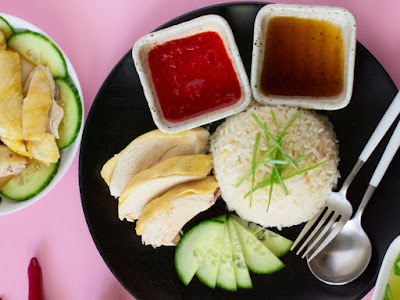Hainanese chicken rice is Singapore's signature dish--a staple food in that wealthy Asian nation. Having little domestic chicken production, Singapore is reliant on imports from countries like Malaysia. Given its limited sources, Singaporeans now have to cope with this shortage. Let's begin with constraints on the supply end in Malaysia:
Malaysia, itself facing soaring prices, has decided to halt chicken exports until local production and costs stabilise. Prices have been capped since February at 8.90 ringgit ($2.03) per bird and a subsidy of 729.43 million ringgit ($166 million) has been set aside for poultry farmers.
Chicken feed typically consists of grain and soybean, which Malaysia imports. But the government is having to consider alternatives amid a global feed shortage. Lower quality feed means the birds are not growing as fast as usual, slowing down the entire supply chain, said poultry farmer Syaizul Abdullah Syamil Zulkaffly.
In turn, Singaporean food stalls have been feeling the pinch. To be sure, there are other sources of chicken such as Brazil. The problem, however, is that Brazil is much farther away than nearby Malaysia, necessitating freezing of chickens to the detriment of freshness and taste:
Singapore, although among the wealthiest countries in Asia, has a heavily urbanised land area of just 730 square km (280 square miles) and relies largely on imported food, energy and other goods. Nearly all of its chicken is imported: 34% from Malaysia, 49% from Brazil and 12% from the United States, according to data from Singapore Food Agency (SFA).
A plate of simple poached chicken and white rice cooked in broth served with a side of greens is a dish beloved by the country's 5.5 million people, and is usually widely available for about S$4 ($2.92) at eateries known as hawker centres.
The SFA has said the shortfall can be offset by frozen chicken from Brazil, and has urged consumers to opt for other protein sources like fish.
Singapore being a wealthy country with more refined tastes, some restaurateurs would rather serve something else rather than frozen Brazilian chicken:
Some vendors have said they will stop selling chicken altogether and instead find alternative dishes – bad news for fans of Singapore’s much-loved dish of poached chicken, served with rice cooked in stock, and chilli dip.
The owner of the popular eatery Tian Tian Hainanese Chicken Rice told the Singaporean outlet The Straits Times that it would stop serving chicken dishes if it could not get fresh supplies. Its founder, Foo Kui Lian, said they would instead “bring back dishes like fried tofu, fried pork chop and prawn salad, but we will not use frozen chicken”.
The Singapore Food Agency has encouraged the public to use frozen chicken, which is imported from countries such as Brazil, or to try alternative meat or fish, and to refrain from buying more than they need.
Singapore's situation has been likened to McDonalds without burgers, but the analogy is not quite correct in that they do have chicken--albeit of the frozen variety. Still, it's another timely illustration of food shortages you encounter nowadays due to supply chain disruptions occurring worldwide.

